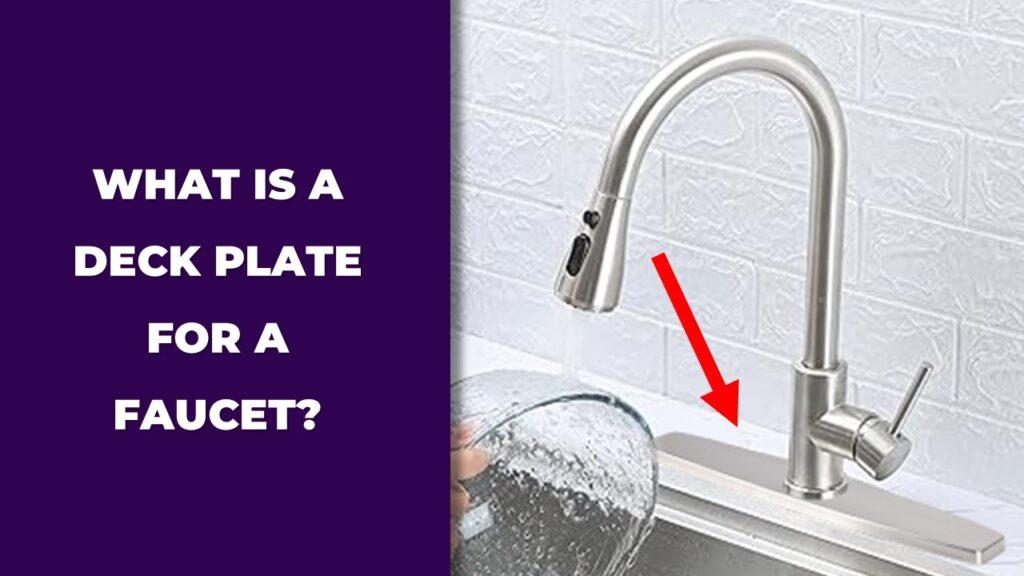
A deck plate for a faucet is a metal plate that covers extra holes in a sink or countertop, giving it a neat, finished look. It’s handy when you switch from a three-hole faucet to a single-hole design, helping stop leaks under the sink and keeping the faucet steady.
In this article, we’ll explain what a deck plate does, when we need one, how to pick the right one, and how to install it. We’ll also share ideas for covering extra holes if we decide not to use a deck plate. Let’s make it simple and practical.
What Is a Deck Plate for a Faucet?
A deck plate for a faucet is a flat metal plate that covers extra holes in a sink or countertop, helping create a clean and polished look. It’s often used when we replace a multi-hole faucet with a single-hole faucet or when we want to cover unused holes in the sink.
Think of a deck plate like a cover-up for those holes we don’t need anymore—it hides them, keeps water from dripping into the cabinet below, and makes the whole faucet setup look neat and tidy. Most deck plates are made of metal and come in different finishes like chrome, brushed nickel, or matte black to match the faucet style.
Why Do Faucets Need Deck Plates?
Faucets need deck plates to cover unused holes in the sink, stop water from leaking into the cabinet below, and make the faucet installation look clean and finished. Without a deck plate, those extra holes can look messy and leave space for water to seep in.
Here’s why we might use a deck plate:
- Covers Extra Holes: If our sink has three holes but we’re using a single-hole faucet, the deck plate covers the extra two.
- Prevents Water Leaks: It acts as a barrier so water doesn’t drip into the cabinet underneath.
- Stabilizes the Faucet: It gives the faucet a flat, steady base so it doesn’t wobble.
- Improves the Look: The deck plate creates a seamless, polished finish that makes the sink and faucet look like they belong together.
Do You Really Need a Deck Plate?
No, we don’t always need a deck plate for a faucet. It depends on the faucet we’re using, the sink setup, and how many holes are in the sink. A deck plate is useful, but it’s not always a must-have.
Let’s break down when a deck plate is helpful, when we can skip it, and the pros and cons.
When a Deck Plate Is Helpful
A deck plate is helpful:
- When we’re replacing a three-hole faucet with a single-hole faucet.
- If we want to cover extra holes for a clean look.
- When we want extra protection from water leaks.
- If we want the faucet to match the sink style and finish.
When You Can Skip It
You can skip a deck plate:
- When we have a sink with just one hole and a single-hole faucet.
- If we plan to use the extra holes for a soap dispenser, filtered water tap, or air switch.
- When we prefer a minimalist, modern design without extra hardware.
Pros and Cons Table
The pros and cons of a deck plate are as follows:
| Pros of a Deck Plate | Cons of a Deck Plate |
| Covers extra sink holes | Adds an extra part to install |
| Helps prevent water leaks | Might not match all sink styles |
| Makes the faucet stable | Can add to the faucet cost |
| Creates a polished look | Not needed for all setups |
How to Choose the Right Deck Plate for Your Faucet
Choosing a deck plate might seem like a small detail, but it makes a big difference. We get it, when you’re staring at that sink and faucet combo, it can feel a bit confusing. Do you need a deck plate? Will it fit? Does it even matter?
Here’s the thing: a deck plate is there to cover those extra holes in your sink, help keep water from slipping underneath, and make everything look clean and finished. Picking the right one comes down to a few simple points:
- Measure Your Sink Holes: Grab a tape measure and check the spacing; most are 4-inch or 8-inch setups. You need to know this before buying anything.
- Check the Fit: Not all deck plates fit every faucet. Let’s make sure the one you pick matches the faucet you’re installing.
- Match the Look: If your faucet is chrome, a shiny silver plate looks good. If your faucet is matte black, don’t go grabbing a gold plate. Let it match.
- Shape Matters Too: Some plates are long and flat, while others are smaller. Pick one that fits the space without looking weird.
- Quality Counts: A cheap, thin plate might bend or scratch easily. Go for a solid, well-made one; it’s worth it.
We’re here to help you figure it out. Take a breath, check those holes, and you’ll make the right choice.
How to Install a Faucet Deck Plate (Step-By-Step Guide)
Installing a deck plate isn’t something we do every day, and it’s okay to feel a little unsure. But once we walk through it, you’ll see it’s not that bad. You’ve got this; we’re here to help you do it right.
Here’s how to install a deck plate without the headache:
- Turn Off the Water: Go under the sink and twist the shut-off valves. No one wants a flood on their hands.
- Remove the Old Faucet (If Needed): Loosen the nuts holding it in place. Take your time, and maybe keep a towel nearby for drips.
- Clean the Area: Wipe down the sink surface so the deck plate sits flat. Get rid of any old gunk or putty.
- Place the Deck Plate: Line it up over the holes. It should sit nice and flat, covering the extras.
- Add a Seal: We like to use plumber’s putty or a little silicone under the plate; it helps stop water from sneaking underneath.
- Install the Faucet: Set the faucet in the holes and tighten the nuts underneath. Don’t go Hulk-strong on it; just snug enough so it stays put.
- Turn the Water Back On: Check for leaks. A little water test now saves a lot of trouble later.
Take your time, work steady, and don’t stress. If you hit a snag, that’s what we’re here for.
Common Mistakes to Avoid With Deck Plates
Let’s be real; nobody wants to waste time or money redoing a faucet job. That’s why it’s smart to know the common mistakes so you can skip the headaches.
One big mistake is grabbing the wrong size. If the deck plate doesn’t fit your sink’s hole spacing, it won’t cover the holes properly, and you’ll end up with gaps or leaks. We’ve seen it happen more than once; it’s frustrating, and it’s avoidable.
Another problem? Forgetting to seal the plate. You might think, “It’s just a plate, it’ll be fine.” But even a tiny gap can let water sneak in, drip into the cabinet, and cause damage over time. That’s why it’s worth taking the extra two minutes to seal it right.
And here’s a little thing people don’t always think about: the finish. A deck plate that doesn’t match your faucet sticks out like a sore thumb. If you’ve got a sleek black faucet and a shiny silver plate, it’s going to bug you every time you look at it. Spend a moment to match it up; it’s a small thing, but it makes your sink look like it belongs in your space.
We’ve been there. We know the little stuff matters. Let’s get it right the first time so you can move on with your day.
Alternatives to Deck Plates (Other Uses for Extra Holes)
If you’re not using a deck plate, don’t worry—you’ve got options. A deck plate isn’t the only way to cover those extra holes in your sink. We know it can feel like a small thing, but when you’re standing there looking at extra holes and wondering what to do, it matters.
Here are some smart alternatives you can use:
- Add a Soap Dispenser: This makes washing dishes easier and keeps your countertop less cluttered.
- Install a Filtered Water Tap: If you drink a lot of water or tea, a filtered tap in an extra hole is a nice upgrade.
- Try an Instant Hot Water Tap: Perfect for quick tea or coffee lovers, this gives you hot water on demand.
- Use an Air Switch for Your Garbage Disposal: A safe, easy way to turn your disposal on and off without needing a wall switch.
- Add a Glass Rinser: This small tool fits into an extra hole and is great for rinsing cups, mugs, or baby bottles.
- Use a Simple Hole Cover: If you’re not ready to add anything, a basic hole cover keeps it clean and dry.
Your sink doesn’t have to stay boring—these little add-ons can make it work smarter for you.
Final Thoughts: Is a Faucet Deck Plate Worth It?
If you’re replacing a faucet or changing your sink setup, a deck plate can save you a lot of hassle. It covers extra holes, keeps water from leaking into the cabinet, and gives your sink a clean, finished look. It’s one of those things you might not think about at first, but it does make a difference.
That said, you don’t always need a deck plate. If you have a single-hole sink or you want to use the extra holes for a soap dispenser or filtered water tap, you can skip it. It really depends on what you want your sink to do.
We’re here to help you figure it out. Think about how you use your sink, what accessories you want, and whether a deck plate makes sense for your setup. It’s a small detail, but when you get it right, it helps your faucet and sink look and work better for the long haul.
Related FAQs
What is the standard size of a faucet deck plate?
Most deck plates are made for 4-inch or 8-inch sinks, but you can find different sizes depending on your faucet and sink setup.
Can I install a faucet without a deck plate?
Yes, you can. If your sink has only one hole, or if you plan to use the extra holes for other fixtures, a deck plate isn’t needed.
Are deck plates universal across all faucet brands?
Not always. Many deck plates fit standard faucet sizes, but it’s smart to check the specs for your faucet and sink before you buy.
Do I need a deck plate for a bathroom faucet?
You might, but not always. If your sink has extra holes that you don’t plan to use, a deck plate can cover them. If not, you can skip it.
How do I cover sink holes if I don’t use a deck plate?
You can install accessories like a soap dispenser, air switch, or filtered water tap in those holes. Or, you can use a simple hole cover to keep the area clean and dry.

Dylan Foster is a family man with years of hands-on experience in plumbing, household maintenance, and fixing everyday issues around the home. A former plumber, Dylan knows what it’s like to deal with tricky leaks, worn-out parts, and all the little problems that pop up in a house. From plumbing repairs to kitchen fixes and garden hose setups, he’s done it all. Dylan shares real-world solutions to help others keep their homes running smoothly and avoid costly mistakes.




